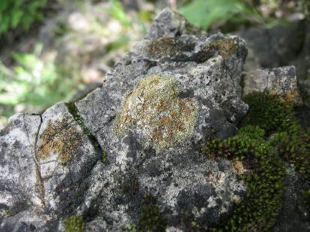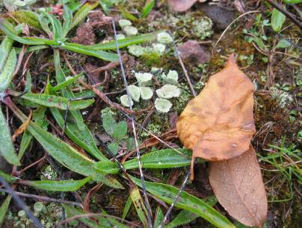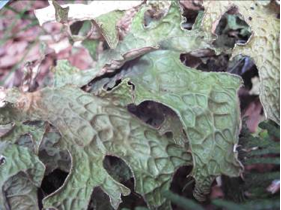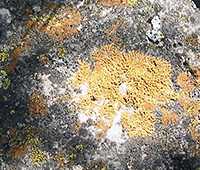What are lichens?
Lichens are organisms in a symbiotic relationship (long-term interaction between different biological organisms) between algae, fungi, and sometimes cyanobacteria. Some scientists view them as mini-ecosystems. The dominant partner in this symbiosis is the fungus; all lichen species are classified by their fungal component. Interestingly, there are only a few species of algae that form lichens, but these algal species can produce thousands of different lichens with different fungi.
There are over 14,000 species of lichens world-wide in many varied forms and vibrant colors. Lichens generally come in the following three growth forms:
Crustose: the surface of the lichen is directly attached to the substrate on which it grows (example:Caloplacasp.).

Fruticose: these are lichens with shrubby-like growth (example: Cladonia sp.).

Foliose: these are lichens with leafy, lobed growth (example: Lobaria sp.).

What do these two (and sometimes three) different organisms get out of their symbiotic relationship?
Fungi cannot make their own food, so the algae (photosynthesizing organism) provide the fuel (carbohydrates) for the fungi to grow. In turn, the fungus provides a safe, protective housing and secures moisture for the algae.
How do lichens reproduce?
Lichens reproduce sexually and asexually. Some lichens have specialized sexual structures called apothecia, which produce spores containing just the fungi. After the spores are released into the environment, they need to find an algae to begin their lichenized lifestyle. Mysteriously, scientists have never observed sexual reproduction in the lab. Asexual reproduction particles are made in isidia or soredia, which produce an alga wrapped in the filaments of the fungi. Once these asexual spores are released and find a substrate, it can begin growth. In either reproductive mode, growth is slow, on the order of millimeters and centimeters a year!
What do lichens do for ecosystems?
Lichens are extremely important in succession, colonizing bare ground and creating soil (rock weathering) and microhabitats for other vegetation. Reindeer and flying squirrels eat them. Lichens with cyanobacteria fix nitrogen from the atmosphere and make it available to other plants.
What do they do for humans?
Lichens have a variety of uses, including dyes, teas and cosmetics. Most importantly, lichens are bioindicators of environmental health such as forest health and air pollution. Just the presence or absence of particular species in a particular area can indicate good or poor air quality or even the age structure of a forest. Unfortunately, the diversity of lichens in Milwaukee is much lower due to our air quality. Lichens like Lungwort (Lobaria pulmonaria—my particular holy grail of lichens) are found only in old growth forests. We still have some Lungwort left in Wisconsin, but they can only be found growing on trees in areas of northern WI. We most often see Shield Lichens (Flavoparmelia spp.) and Candleflame lichens (Candelaria spp.) on trees in Milwaukee County. They are extremely tolerant of poor air quality.
How can I look for lichens?
It’s very easy with a good hand lens. The best time to look is after a good rain when the lichen colors become more vibrant. Lichens that you probably did not see when dry almost “bloom” from the moisture on the trees. I urge you to take a hand lens or even a magnifying glass, walk up to a tree in your neighborhood and look for a yellow foliose (leafy) lichen on the bark. It’s most likely Candelaria concolor. Your first lichen!
When and where can I look for lichens?
Join the Urban Ecology Center Research and Community Science Team and Marie Trest, UW-Madison Lichen Expert, on a foray to the Cedarburg Bog on August 17th from 10am to 5pm. Price is $45 for members and $50 non-members and includes a bag lunch. We’ll take a Center van from Riverside Park to the Cedarburg Bog and other locations where you’ll learn more about lichen biology, ecology and why these symbiotic organisms are important to the ecosystems in which they live.
Click here to register for this event.
For more information on lichens, check out the Lichens of North America by Irwin Brodo, Sylvia Duran Sharnoff, and Stephen Sharnoff. Their book is filled with beautiful photographs of hundreds of species.




